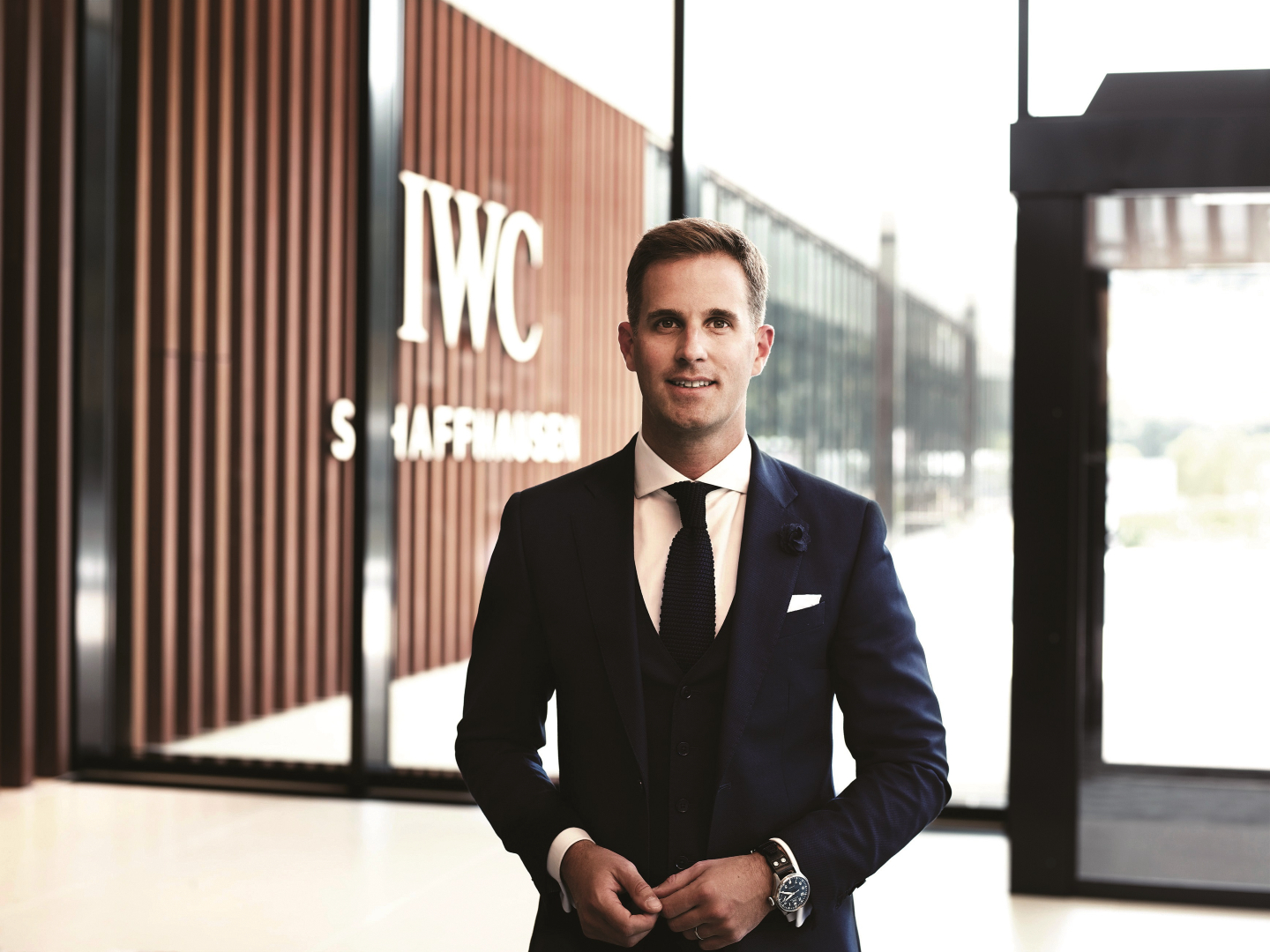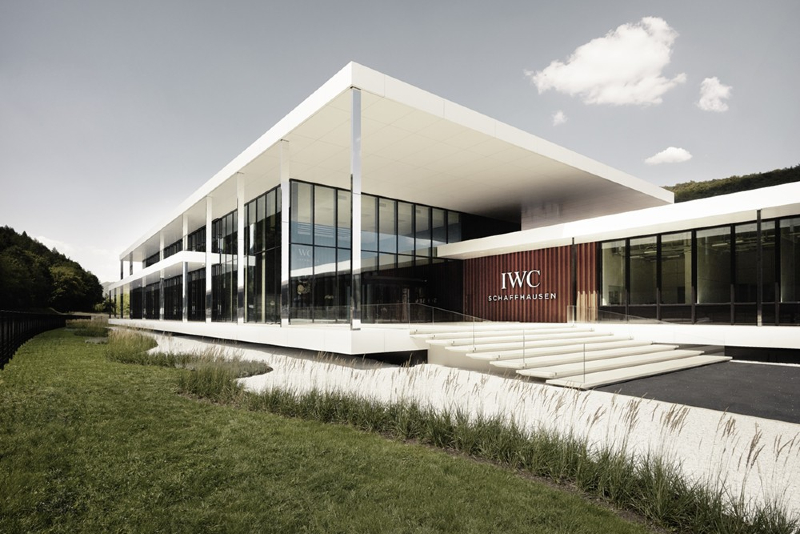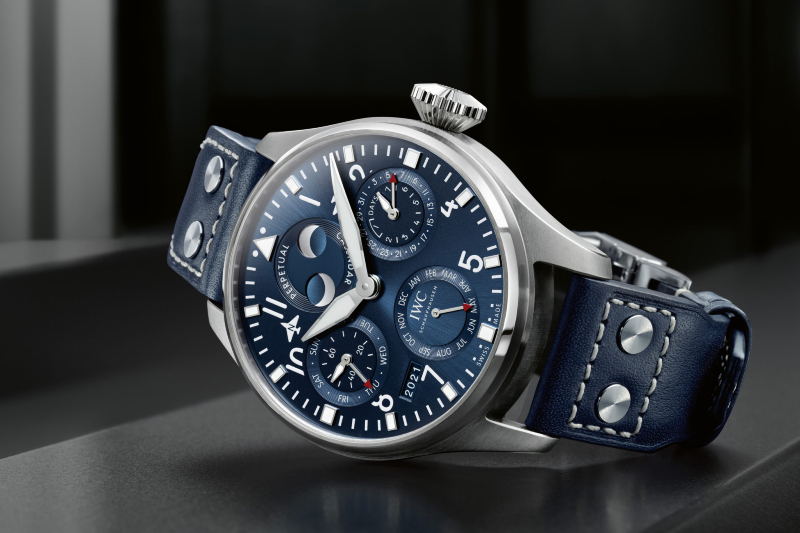
Grainger-Herr’s stewardship of the watchmaker is guided by his experience from various positions across different parts of the company (All photos: IWC Schaffhausen)
You could say that IWC Schaffhausen CEO Christoph Grainger-Herr was always meant to head a luxury watchmaking maison. For example, I can think of few other three-year-olds who named their soft toy Patek, nor are there many newly practising architects who were handpicked by the Richemont Group to design a watchmaking museum for IWC Schaffhausen.
An interior design graduate from the University of the Arts in Basel and Bournemouth University, Grainger-Herr would later be handpicked by IWC’s then CEO Georges Kern to work in the trade marketing department, and later on, take the driver’s seat to design the Manufakturzentrum, IWC’s new home that opened its doors in 2018.
“The manufacture is a bit bigger than the museum, but a project that is so close to my heart, and that I am so proud of,” Grainger-Herr gushes. “It’s a statement of tradition meeting extreme modernity — you feel it is anchored in the city of Schaffhausen and looks like it has been there forever. But at the same time, it expresses a forward-looking attitude.”
Owing to Covid-related lockdowns, the 43-year-old has spent more time in Schaffhausen than he ordinarily would have as CEO, whose role is to travel to the watchmaker’s various markets all over the world. But there is a silver lining to this, he says. “This time last year, we didn’t know what Zoom was. Now, we know a bit too well,” he quips. “To have this kind of connectivity is something I’ve really enjoyed and is a major upside of this situation. With less travelling, I do more talking and spend less time sitting in airplanes.”
manufakturzentrum_iws.jpg

IWC’s initial reaction to Covid-19 was to ensure the safety of its partners and workforce. And once it did, it quickly pivoted to providing a more digitally focused platform to serve its customers. Live streaming, video chats, online client consultations and virtual boutiques quickly became the norm — or at least more common — and IWC even patented the Cyberloupe, whereby the watchmaker’s magnifying glass is equipped with a camera and a network connection.
The Cyberloupe streams the image that the watchmaker sees in real time to a screen, allowing watch enthusiasts to experience the inner workings of a mechanical movement in a never-seen-before way.
On the communication side, IWC’s Time Well Shared initiative featured online lectures, speeches and webinars delivering alluring insights and knowledge from key employees, brand ambassadors and partners, connecting with the brand’s fan base at a time they needed to be diverted from the constant flow of bad news. “It has tested everyone’s agility, but that has become a constant in all our lives,” says Grainger-Herr, referring to the pandemic. “The scale is different this time, but I think we are used to adapting rapidly to evolving global situations.”
The brand also strengthened its position on social media platforms, in particular, the voice-based Clubhouse. In many respects, this is not anything new, says Grainger-Herr, but a contemporary version of what luxury has always been about — building personal relationships between the client and the watchmaker.
“For a long time, it was more about big brands communicating only one way. Clubhouse is the first platform that allows any discussion community in the world to bring the people behind the brand into the rooms and to start a dialogue that is alive, direct and unscripted. It brings a global community that was completely disparate before together into the same space. Once upon a time, it would have been very difficult to connect collectors in Malaysia with those in Texas together with watchmakers in Switzerland. But today, it is a non-issue,” he observes.
The one thing that didn’t change, though? The watchmaker’s long-standing plans in terms of new releases. Last year, the key collection was the Portugieser while in 2021, the focus has been the Pilot line of watches. “The long-term nature of our business is very much intact. We did not fundamentally change the strategy for the collection launches, which goes back to investment in manufacturing, the ability to bring more in-house movements and higher material quality to our collections — that for us remains unchanged.”
Coincidentally, Grainger-Herr’s favoured timepiece is a Pilot’s watch, although from a previous collection — the Big Pilot Titanium 46mm Safari.
We talk briefly about the new Pilot collection, and it emerges that we have a common favourite — the Big Pilot Perpetual Calendar with a stunning blue dial. Originally developed by IWC’s legendary watchmaker Kurt Klaus, this watch boldly reimagines his classic design for a contemporary audience with internal mechanics for synchronised precision and a sapphire case with a clear back to witness the decorated movement.
Another notable release in the collection is the Big Pilot’s Watch Shock Absorber XPL, which features one of the world’s most advanced anti-shock systems, and is a most visually arresting timepiece to boot.
big_pilot_perpetual_calendar_iwc.jpg

Grainger-Herr’s stewardship of the watchmaker is guided by his experience from various positions across different parts of the company. He has been head of trade marketing and marketing departments, executive brand architect, associate director for strategic planning and retail, and then international sales director before being appointed CEO in April 2017.
He created, among other things, IWC’s retail, exhibition and headquarters concepts, communication concepts for key product families as well as distribution strategies online and offline. Thanks to his background in architecture and design, Grainger-Herr has a highly aesthetic vision for the brand. His creative mindset is a key advantage, not only in further developing IWC’s six iconic watch families, but also in building the emotional storytelling worlds that surround them, such as flying, racing or sailing.
“I started here at the beginning of my career as project manager, coming more or less straight out of university with one previous job. My entire professional reality has grown from within — everything I know, I have learnt here,” he says.
“Being from a design our background, you have a more brand-centric view of the business because, ultimately, I believe if we express our brand and design products in a way that makes clients fall in love with them, the rest will fall into place. But if you mess up the brand, the value of the products, it is hard to be successful — distribution and marketing are all afterthoughts in a way. You have to start with something people can relate to and love.”
A former military athlete, Grainger-Herr remains a keen sportsman to this day with a focus on skiing, cycling and running. The father of three is also a self-declared petrol head and has a passion for racing and road car design. This certainly dovetails with IWC’s own involvement in sports, and one that is likely to continue under his stewardship. “At the end of the day, it is fortunate that disciplines such as aviation and motorsport relate to watchmaking very easily — the stories of designing watches, planes and cars have their similarities and result in great adventure,” he muses.
His understanding of Formula One Grand Prix racing evolved a great deal from the perspective of a spectator to someone actively involved in the team and the racers, he adds. IWC has been the official engineering partner of the Mercedes-AMG Petronas Formula One Team since 2013, and enjoys close collaborative relationships with the team’s drivers, Lewis Hamilton and Valtteri Bottas.
Grainger-Herr enjoys a close relationship with Hamilton and has great respect for his untiring work ethic, as well as retired racer David Coulthard, who remains a passionate friend of the brand. All three personalities have been featured in the Time Well Shared initiative.
This brings us back to the topic of the pandemic, and what the situation will be like for the luxury industry going forward. Grainger-Herr is remarkably bullish about it. “In the pandemic’s absence of noise, people have started to question their own patterns of consumption. A product category like ours, made in the same place in the heart of Europe in excellent working conditions, powered by the energy of the River Rhine as FA Jones originally intended — it is creating jobs, enhancing skills and will last you a lifetime and more. The only power that goes into these products is from the wearer, and we promise that we can service this watch forever! In the context of the global matter of environmental impact and conscious consumption, I think we make a very strong case for it.
“Another thing we’ve seen is — and this has been true since the early part of our existence — no matter how hard things get or how uncertain the world is, humans still need the symbolism we find in art and objects that surround us, the hope we place in something we are passionate about. Watches represent this constant; as things change around us, this is the thing I can pass down to the future generation and this gives me a glimpse into eternity. This becomes a compass when many things around us are in flux,” he says philosophically.
It is a foregone conclusion that we do not acquire a mechanical timepiece to tell time, but it remains one of the world’s most symbolic items with which to record the passage of life, to mark meaningful occasions and to appreciate the elegant beauty of passing hours, minutes and seconds. “This aspect has been enhanced by the pandemic, not the other way around,” says Grainger-Herr. Indeed.
This article first appeared on Jul 19, 2021 in The Edge Malaysia.


